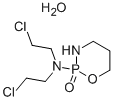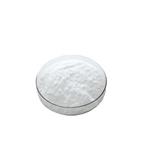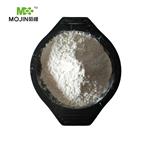Chemical Properties
White to Off-White Solid
Uses
alkylating agent in cancer therapy
Uses
An immunosuppressive, cytotoxic apoptosis inducer.
Uses
It is a cytotoxic nitrogen mustard derivative widely used in cancer chemotherapy. It cross-links DNA, causes strand breakage, and induces mutations. Its clinical activity is associated with a decrease in aldehyde dehydrogenase 1 (ALDH1) activity. This substance is listed as a known human carcinogen.
Uses
antineoplastic, alkylating agent
Uses
Cyclophosphamide monohydrate is used to treat cancers, autoimmune disorders and AL amyloidosis. It is a nitrogen mustard alkylating agent and reacts with deoxyribonucleic acid (DNA) to get its alkylated derivative. It is also involved in cancer research as a tool that induces apoptosis in tumor cells.
Definition
ChEBI: The monohydrate of cyclophosphamide.
brand name
Cytoxan (Bristol-Myers Squibb); Neosar (Sicor).
General Description
Fine white crystalline powder with a slightly bitter taste. Little or no odor.
Air & Water Reactions
Water soluble. Sensitive to moisture and light. Aqueous solutions may be kept for a few hours above room temperature, but hydrolysis occurs at temperatures above 86°F. Cyclophosphamide monohydrate undergoes both specific acid and specific base catalysis at extreme pHs. Spontaneous hydrolysis in aqueous solutions.
Reactivity Profile
Polymerization can occur at temperatures > 120° F. Cyclophosphamide monohydrate reacts with strong oxidizing agents, strong acids and strong bases. Benzyl alcohol increases rate of hydrolysis.
Fire Hazard
Cyclophosphamide monohydrate is probably combustible.
Biochem/physiol Actions
Cyclophosphamide is a cytotoxic nitrogen mustard derivative widely used in cancer chemotherapy. It cross-links DNA, causes strand breakage, and induces mutations. Its clinical activity is associated with a decrease in aldehyde dehydrogenase 1 (ALDH1) activity.
Safety Profile
Confirmed human
carcinogen. Poison by ingestion and
intravenous routes. Experimental
reproductive effects. Mutation data
reported. When heated to decomposition it
emits toxic fumes of Cl-, PO,, and NOx.





